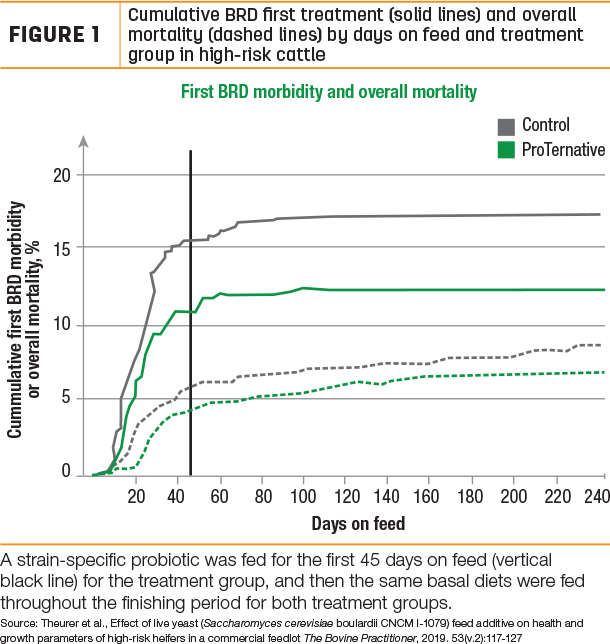Many producers I’ve talked to seem interested – and exhausted – by the number of probiotic and prebiotic feed options. Yeasts, yeast derivatives, yeast cultures and dead yeast products often are called probiotics and prebiotics. These products can absolutely provide benefits; however, not every product is going to be the right fit for your operation.
Here are five tips for incorporating probiotics and prebiotics:
- Choose a product that is alive
- Feed the growth of those positive microbes with prebiotics
- Select a specific strain that’s proven to work in cattle
- Purchase from a trusted manufacturer
- Feed it daily
Probiotics: Alive and viable
Probiotics and prebiotics are actually two different – and often complementary – products. A probiotic is defined as a live microorganism which, when fed in adequate amounts, confers a health benefit on the host. Probiotics must be alive when consumed to be effective because they must continue to live once in the digestive system. In fact, many governmental agencies will only authorize an efficacy claim on performance – such as improved feed efficiency – when the probiotic microorganism is alive and viable.
Prebiotics: Feeding positive benefits
Prebiotics are any non-viable microorganism or fraction of a microorganism supplying key micronutrients needed for growth by the digestive microorganisms in the digestive tract. The result is a final product that does not contain any live cells. Prebiotics can offer additional nutrition and stimulate the bacteria in the gut.
That’s why probiotics and prebiotics can be used together. Likening the digestive system to an engine, prebiotics are like “gas” which can help feed the animal’s existing microbial communities. Probiotics are like the “oil” that keep an engine running smoothly and efficiently because live specific yeast strains produce measurable animal responses in health, live animal performance and/or carcass traits.
How do they work?
Both probiotics and prebiotics work by modulating the balance of, and activities within, the gastrointestinal (GI) microbiota. The microbiota is a complex mixture of naturally occurring microorganisms in the animal’s gut that includes bacteria, protozoa and fungi. In modern livestock production, many challenges to growth and performance are caused by disruption of the intestinal environment and microbiota.
There is conclusive evidence that microbes within the GI system communicate and influence many aspects of an animal’s performance and well-being. Microbes communicate with the brain and central nervous system. We now understand the lower gut is the primary immune organ of cattle. Therefore, we can power the animal’s immune response if we can positively affect the rumen and influence the microbiota of the GI tract.
Some probiotics impact digestion directly, or they can reshape the intestinal microbiota by favoring microbes contributing to digestive function. By balancing good and harmful bacteria, issues can be avoided or limited, including:
- Loss of mucosal intestinal integrity
- Digestive disorders
- Infections
- Weakened immune response
- Inflammatory response
- Reduced animal performance
Strain selection matters
Careful strain selection is essential for displaying a specific probiotic function. For example, purchasing a commercial yeast product intended to make wine probably won’t help your cattle improve their average daily gain (ADG).
Each strain of yeast or bacteria has its own unique growing, handling and storage preferences. Therefore, it is important for producers to ensure their probiotic is pure, consistently produced and packaged strategically to maximize product quality and performance all the way to the feedbunk.
Research on specific probiotic strains in cattle is accumulating, as these products are more widely used. For example, one probiotic – Saccharomyces cerevisiae boulardii CNCM I-1079 – has been proven to positively activate cattle’s immune response and help decrease the need for treatment. Studies in cattle have proven that S. c. boulardii CNCM I-1079 can improve cattle feed uptake, lower morbidity and mortality.
Additionally, cattle fed S. c. boulardii CNCM I-1079 in this study were 9.7% more likely to grade Choice compared to controls, and severe liver abscesses were reduced by 48% compared to the controls. This specific probiotic strain really focuses on health. In another study of cattle sourced from auction barns across the southeastern U.S., those fed S. c. boulardii CNCM I-1079 had 39% fewer re-treatments for bovine respiratory disease (BRD) as compared to controls.

Another strain of S. cerevisiae – CNCM I-1077 – has been proven to optimize rumen function by positively increasing rumen pH and fiber digestibility in cattle. In fact, based on data submitted by Lallemand on this strain, the FDA allows a functionality claim that says “aids in maintaining cellulolytic bacteria populations in the rumen of animals fed diets containing greater than 50% concentrate.”
Research in cattle eating a high-fiber diet including corn silage showed that including S. cerevisiae CNCM I-1077 helped improve fiber digestibility, increased feed efficiency by 8%, and cattle even saw a 6.7% improvement in ADG. In fed cattle, S. cerevisiae CNCM I-1077 influenced feeding behavior patterns, with 18% of steers demonstrating longer bunk visits and spending 29% more time with their heads down at the trough.
While both S. c. boulardii CNCM I-1079 and S. cerevisiae CNCM I-1077 are from the same species of yeast, each strain produces different effects when fed to cattle. It’s a perfect example of why strain selection matters.
Manufacturing counts
Manufacturing quality also is important for probiotics. As living organisms, these products are negatively affected by harsh environments and poor handling. For example, probiotic organisms can easily be killed when using high heat to create pelleted feed. If the organism isn’t alive, the benefits to your animals aren’t there either. Look for manufacturers who have a microencapsulation or coating technology to keep probiotics alive during various feed manufacturing processes.
Including into the ration
Keep in mind, probiotics must be fed on a daily basis to maintain levels high enough to see benefits in the animal. Live probiotics do not reproduce or colonize in the animal’s digestive system, so daily consumption of a probiotic ensures the right amount of microorganisms are available to do the intended job. The good news is: These products can be easy to include in the ration and have few palatability challenges. In addition, they can be used with any program, from all-natural to traditional production.
Summary
Focusing on products that have proven to work is the first step to seeing changes on your operation. Following these criteria can release the power within these microorganisms to improve animal well-being and productivity – not to mention your operation’s profit margin.
References omitted but are available upon request by sending an email to the editor.








